My Trans-Canada Rail Journey – Part 10
Still running two hours late, the Canadian heads northwest out of Winnipeg with the setting sun ahead and off to the left. We’re crossing the prairie now – the land gently undulating past the horizon – either vast fields of wheat or pasture dotted with grazing cattle and some occasional deer and antelope.
There has been a crew change in Winnipeg and my genial car attendant, Bob Brown, has been replaced by an attractive young lady named Ciji Kahn, who will be looking after us from here to Vancouver.
Each of the dining cars has a new crew, too … two cooks, a steward and three servers. Because the train is running late, the Toronto crew handled the first two dinner seatings, then handed things off to this new group for the third. And it all happened seamlessly. “You’ve got to be flexible to work for a railroad,” says the new steward cheerfully.
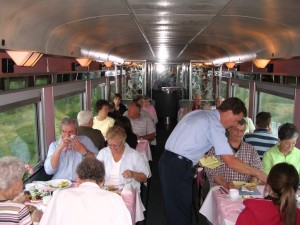 Tonight at dinner I’m joined by a stylish French Canadian women en route to a conference in Saskatoon – since we’re still two hours late, she will be leaving the train at about 3:00 a.m. – and an Australian couple who are rail travel enthusiasts. They’re working their way through a check list of long-distance train journeys and are quick to pronounce the Canadian as one of the better trips they’ve taken over the years.
Tonight at dinner I’m joined by a stylish French Canadian women en route to a conference in Saskatoon – since we’re still two hours late, she will be leaving the train at about 3:00 a.m. – and an Australian couple who are rail travel enthusiasts. They’re working their way through a check list of long-distance train journeys and are quick to pronounce the Canadian as one of the better trips they’ve taken over the years.
My choices for dinner are excellent: onion soup, a generous slice of pork roast garnished with a glazed onion sauce and a sprig of fresh rosemary, nicely browned potatoes, mixed vegetables, and a delicate apple torte for desert. And – Oh, yes – a very acceptable Canadian sauvignon blanc to accompany both the meal and the glorious sunset occurring across the endless vista ahead of us – orange giving way to pink, streaked with wisps of purple clouds.
Between Toronto and Vancouver there are 67 stops listed in the official VIA Rail timetable. Of these, only eleven are regular stops. The remainder are “flag stops” where the train will not stop unless there is someone getting on or getting off … and then only with 48 hours notice. One such stop is Brandon North, 3-and-a-half hours to the west of Winnipeg. The tiny station building could easily be hauled off on a flatbed truck. The Canadian stops for no more than 30 seconds to allow a young man in his late teens to board, leaving a middle-aged couple waving after him on the tiny platform. The woman is dabbing at here eyes with a paisley handkerchief; her husband’s expression is stolid, grim.
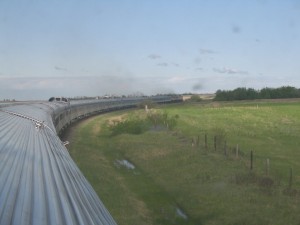 Saskatoon comes and goes during the night and morning finds the Canadian in the province of Saskatchewan, still on the prairie, with more wheat and horses and cattle and, every hour or so, the huge grain elevators. But today, oil wells have been added to the passing scene, one or two every few miles.
Saskatoon comes and goes during the night and morning finds the Canadian in the province of Saskatchewan, still on the prairie, with more wheat and horses and cattle and, every hour or so, the huge grain elevators. But today, oil wells have been added to the passing scene, one or two every few miles.
There’s more wildlife today, too: deer and antelope, lots of bald eagles, Canada geese and even sea gulls, congregating in what appears to be a low spot in the prairie that’s filled with rainwater. We trundle onto a trestle then begin skirting a picturesque little valley. Below us is a stream winding away to the south with four beaver dams and lodges clearly visible. Every so often we pass a small ranch house, most with trees planted on several sides to help break the prairie winds. One sits in front of a corral that contains a dozen or so buffalo. Another small building sports a large sign: “Bushwacker’s Mulching” with a phone number.
Sometime during breakfast we cross from Saskatchewan into Alberta and we’re clearly in beef country, vast pastures with cattle grazing placidly and calves, lots of them, frisking about their mothers. By late morning we reach Edmonton, a city of nearly 900,000 people that has been a boom town for most of its existence – the fur trade, the Yukon gold rush and then oil. It’s a sprawling city that’s justly famous for many acres of parks along the banks of the North Saskatchewan River which bisects the city.
Continuing due west after a 45-minute stop in Edmonton, the train skirts Wabamun Lake for several miles, passing a small marina sheltering several sailboats and fishing cabins dotting the shoreline, most with floating piers jutting out into the lake.

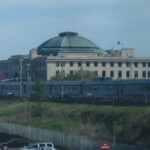
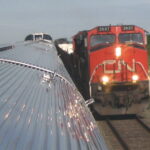
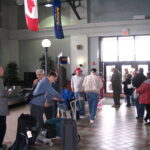
I didn’t know that you ever got snow there. Proof that reading blogs *is* educational :)
Believe it or not, we had snow here on Maui in early February … on the summit of Haleakala, the 10,000-foot volcano. Families took their kids up there to throw snowballs. It lasted about two days. Thanks for the comment! I’m delighted to have folks looking at my posts. Aloha.
I, too, was wondering about the snow :)
I’d love to take this trip myself–I’ve never been west of Thunder Bay, ON. I’m not sure how two-year-old Apricot would react to the idea, but I’m sure she’d enjoy it when she’s a bit older.
The snow is melting in the corridor, but we’ve had so much of it this year that it’s hard to tell!
Thanks for the nice comment. Much appreciated. No snow because I was traveling in the last week of May, 2007. There was snow in the Rockies, however, and I’l be sure to post some photos of that in the next day or so. It is indeed a wonderful trip. I’ve made it three times and am planning to do it at least once more — next time in the dead of winter. It would, I think, make an interesting article … what kind of different problems the sevice and operating crews face, who the passengers are and why they’re traveling in the winter time, etc. Aloha.
Something’s missing from these pictures, i.e., snow. Don’t tell me that spring has already hit the rest of Canada! Please let it come to the Windsor-Quebec City corridor sometime soon.
But I jest. This is a lovely description of what sounds like a lovely trip. I particularly like the photo of the dining car. You can bet that I will be checking in at this blog on a regular basis!
Vivian, your virtual VIA Rail service attendant